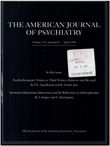The DSM-IV field trial for mixed anxiety-depression
Abstract
OBJECTIVE: This field trial was designed to answer four questions. First, are patients presenting with anxious or depressed symptoms that are associated with significant impairment but do not meet DSM-III-R definitional thresholds for axis I anxiety or mood disorders? Second, is the impairment experienced by these patients simply the consequence of the severity of their medical conditions? Third, what percent of these patients present with depressive symptoms only, anxious symptoms only, and a mixture of both? Fourth, how should the operational criteria for the syndrome(s) presented by these patients be defined? METHOD: A total of 666 patients from five primary care medical sites and two outpatient mental health sites were administered a semistructured psychiatric interview. RESULTS: Patients presenting with affective symptoms that did not meet definitional thresholds for DSM- III-R axis I disorders were at least as common as patients with several of the already established anxiety and mood disorders in each of the seven sites, and their disorders were associated with significant distress or impairment. A nonspecific pattern of anxious and depressed symptoms was the modal presentation among these patients with currently subdefinitional threshold disorders, and they could be significantly differentiated in terms of current symptoms from patients presenting with a principal diagnosis of generalized anxiety disorder, major depressive episode, or panic disorder with agoraphobia. CONCLUSIONS: The authors recommend that a mixed anxiety-depression category be included in the DSM-IV appendix for proposed diagnostic categories that need further study. A criteria set is proposed.
Access content
To read the fulltext, please use one of the options below to sign in or purchase access.- Personal login
- Institutional Login
- Sign in via OpenAthens
- Register for access
-
Please login/register if you wish to pair your device and check access availability.
Not a subscriber?
PsychiatryOnline subscription options offer access to the DSM-5 library, books, journals, CME, and patient resources. This all-in-one virtual library provides psychiatrists and mental health professionals with key resources for diagnosis, treatment, research, and professional development.
Need more help? PsychiatryOnline Customer Service may be reached by emailing [email protected] or by calling 800-368-5777 (in the U.S.) or 703-907-7322 (outside the U.S.).



